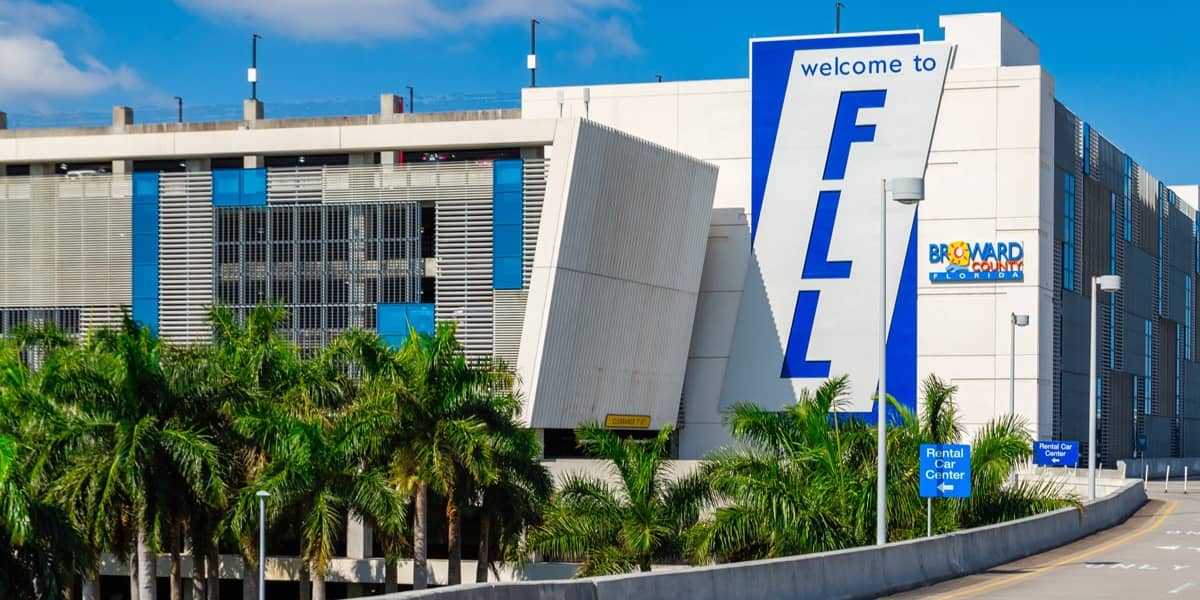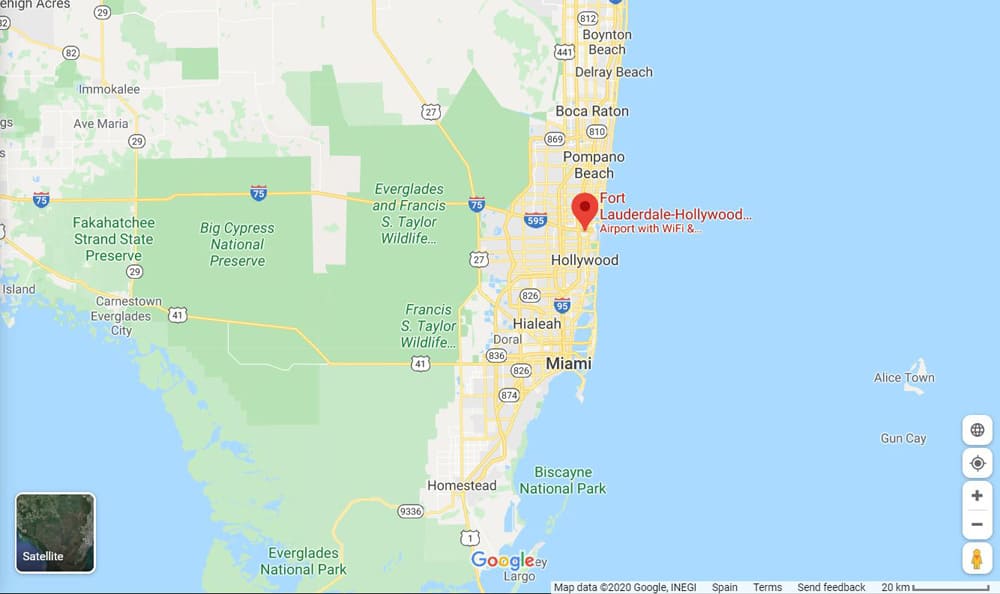Fort Lauderdale Airport Code is one of the most important pieces of information for travelers heading to or from this vibrant Florida destination. Whether you're booking a flight, checking in online, or confirming your travel itinerary, knowing the airport code can simplify your journey. In this article, we will delve into everything you need to know about Fort Lauderdale Airport Code and its significance in modern air travel.
As one of the busiest airports in the United States, Fort Lauderdale-Hollywood International Airport (FLL) plays a crucial role in connecting travelers from all over the world. This airport serves not only Fort Lauderdale but also the broader South Florida region, including Miami and West Palm Beach. Its strategic location makes it a popular hub for both domestic and international flights.
Understanding airport codes like FLL is essential for travelers who want to ensure a seamless experience. In this article, we will explore the history, infrastructure, services, and other key aspects of Fort Lauderdale Airport, ensuring you have all the information you need before your next trip.
Read also:Ali Siddiq Father Unveiling The Legacy Of A Remarkable Figure
Table of Contents
- What is Fort Lauderdale Airport Code?
- Overview of Fort Lauderdale-Hollywood International Airport
- History of Fort Lauderdale Airport
- Airport Facilities and Services
- Terminal Structure and Layout
- Transportation Options
- Popular Destinations Served by FLL
- Travel Tips for Flying Through FLL
- Airport Statistics and Growth
- Future Expansion Plans
What is Fort Lauderdale Airport Code?
The official airport code for Fort Lauderdale-Hollywood International Airport is FLL. This three-letter code is part of the International Air Transport Association (IATA) system, which assigns unique identifiers to airports worldwide. The FLL code is widely used in flight schedules, booking systems, and luggage tags to streamline operations and improve efficiency in global air travel.
FLL not only represents the airport but also serves as a shorthand reference for its location in Fort Lauderdale, Florida. This code is particularly important for travelers who need to quickly identify their departure or arrival airport when booking flights or checking in online. Knowing the airport code can help avoid confusion, especially when multiple airports serve the same metropolitan area, such as in South Florida.
Overview of Fort Lauderdale-Hollywood International Airport
Fort Lauderdale-Hollywood International Airport is one of the largest and busiest airports in the southeastern United States. Located approximately 25 miles north of Miami, FLL serves millions of passengers annually, connecting them to destinations across North America, Latin America, the Caribbean, and Europe. The airport is renowned for its efficiency, modern facilities, and proximity to popular tourist destinations like Fort Lauderdale Beach, Miami Beach, and the Everglades.
Why Choose FLL for Your Travel?
Fort Lauderdale-Hollywood International Airport offers several advantages for travelers, including:
- Convenient location with easy access to South Florida attractions.
- Wide range of flight options from major airlines and low-cost carriers.
- Modern amenities and services, including free Wi-Fi and diverse dining options.
- Efficient customs and immigration processes for international travelers.
History of Fort Lauderdale Airport
The origins of Fort Lauderdale-Hollywood International Airport date back to the early 20th century. Originally established as a military airfield during World War II, the airport gradually evolved into a commercial hub to meet the growing demand for air travel in South Florida. Over the decades, FLL has undergone numerous expansions and upgrades to accommodate increasing passenger volumes and technological advancements.
Key Milestones in the Airport's History
- 1929: The first commercial flights begin at the airport.
- 1942: The airport is converted into a military base during World War II.
- 1962: The airport is renamed Fort Lauderdale-Hollywood International Airport.
- 2008: A major terminal expansion project is completed, enhancing capacity and passenger comfort.
Airport Facilities and Services
Fort Lauderdale-Hollywood International Airport offers a wide array of facilities and services to ensure a comfortable and enjoyable experience for passengers. From dining and shopping to lounges and lounging areas, FLL caters to the needs of all types of travelers.
Read also:Jimmy Fallon Saturday Night Live Characters A Comprehensive Look At His Iconic Roles
Top Amenities at FLL
- Dining Options: Over 30 restaurants and cafes serving a variety of cuisines.
- Shopping: Duty-free shops, souvenir stores, and retail outlets offering everything from electronics to fashion.
- Lounges: Premium lounges for business and first-class passengers, featuring comfortable seating, complimentary snacks, and high-speed internet.
- Family-Friendly Features: Play areas, nursing rooms, and stroller rentals to make travel easier for families with children.
Terminal Structure and Layout
Fort Lauderdale-Hollywood International Airport consists of three main terminals, each serving different airlines and routes. Understanding the terminal layout is essential for navigating the airport efficiently and avoiding last-minute stress.
Terminal Details
- Terminal 1: Serves international flights and some domestic routes.
- Terminal 2: Primarily handles domestic flights, with a focus on low-cost carriers.
- Terminal 3: Hosts a mix of domestic and international flights, including major airlines like Delta and American Airlines.
Transportation Options
Getting to and from Fort Lauderdale-Hollywood International Airport is made easy with a variety of transportation options. Whether you prefer public transit, taxis, ride-sharing services, or rental cars, FLL ensures you have plenty of choices to suit your needs and budget.
Popular Transportation Methods
- Airport Shuttle: Regular shuttle services connect FLL to nearby hotels and attractions.
- Public Transit: The Tri-Rail commuter train and Broward County Transit buses provide affordable and convenient access to the airport.
- Rental Cars: Numerous car rental agencies operate at FLL, offering a wide range of vehicles to suit your travel plans.
Popular Destinations Served by FLL
Fort Lauderdale-Hollywood International Airport serves a vast network of domestic and international destinations, making it a key gateway to the world. From sunny beaches in the Caribbean to bustling cities in Europe, FLL offers something for every type of traveler.
Top International Destinations
- London, United Kingdom
- Paris, France
- Mexico City, Mexico
- Santiago, Chile
Top Domestic Destinations
- New York City, New York
- Los Angeles, California
- Chicago, Illinois
- Dallas, Texas
Travel Tips for Flying Through FLL
To make your journey through Fort Lauderdale-Hollywood International Airport as smooth as possible, here are some valuable travel tips:
Pre-Flight Preparation
- Arrive at least two hours before your scheduled departure for domestic flights and three hours for international flights.
- Check your airline's website or app for real-time updates on flight status and gate information.
- Pack a carry-on bag with essentials like snacks, water, and entertainment to stay comfortable during your trip.
At the Airport
- Use the airport's free Wi-Fi to stay connected while waiting for your flight.
- Take advantage of the airport's lounges and amenities to relax before your journey.
- Be mindful of security checkpoints and follow TSA guidelines to avoid delays.
Airport Statistics and Growth
Fort Lauderdale-Hollywood International Airport continues to grow and evolve, reflecting the increasing demand for air travel in South Florida. Recent statistics highlight the airport's impressive performance and its role as a vital economic engine for the region.
Key Statistics
- In 2022, FLL served over 24 million passengers, marking a significant increase from previous years.
- The airport handles an average of 65,000 passengers daily, with peak travel seasons seeing even higher numbers.
- FLL supports over 30,000 jobs in the local economy, contributing billions of dollars annually to the region's GDP.
Future Expansion Plans
Looking ahead, Fort Lauderdale-Hollywood International Airport has ambitious plans for expansion and modernization. These initiatives aim to enhance passenger experience, increase capacity, and maintain the airport's position as a leading travel hub in the southeastern United States.
Upcoming Projects
- Construction of a new international terminal to accommodate growing passenger volumes.
- Upgrades to existing infrastructure, including improved baggage handling systems and expanded parking facilities.
- Investment in sustainable technologies to reduce the airport's environmental footprint and promote eco-friendly travel.
Conclusion
In conclusion, understanding what Fort Lauderdale Airport Code (FLL) represents is vital for anyone planning to travel through this dynamic airport. From its rich history and modern facilities to its wide range of destinations and convenient transportation options, FLL offers everything you need for a seamless and enjoyable travel experience.
We encourage you to take advantage of the resources and tips provided in this article to make the most of your journey through Fort Lauderdale-Hollywood International Airport. Don't forget to share your thoughts and experiences in the comments below, and explore other informative articles on our website to enhance your travel knowledge.


